This post has already been read 3561 times!
Last week, we examined the Structural Framework for Raising the Next Generation of Leaders, and one very key thing that was emphasized was that for a leader to raise the next generation of leaders, such a leader must have a structure in place that would facilitate such a transgenerational exercise. Today, we want to look at another framework and it has been titled: The Vision-driven Framework for Raising Leaders. One thing that perpetuates our leadership is vision. In most cases, when a vision is properly communicated, and the right people received it or understood it, what usually happens is that such a vision would outlast the vision giver. In Habakkuk 2:2, the Bible says: “then the LORD answered me and said: “write the vision and make it plain on tablets, that he may run who reads it.” When a vision is properly captured and properly communicated, it becomes easier for everyone to be able to run with.
Listen to Podcast: The Vision-driven Framework for Raising Next Generation of Leaders
There is this program that I love to watch on CNN, it is called “The 100 Club.” The program showcases organizations, brands and businesses that have existed for 100 years. One thing that is consistently common with these organizations is the fact that over the decades, they never deviated from the original vision of their founders, despite the fact that many of them were long dead. Even though there were slight modifications along the way, the original vision was strictly adhered to, and that has kept them going for those number of years.
This is the point I am trying to pass across to us. As a leader who wants to raise the next generation of leaders, you must be ready to have a vision that would be passed down to subsequent generation of leaders coming after you. Your vision should not die with you. The fact that you are retiring from your leadership assignment does not mean that your vision should also retire with you. And this is why the vision-driven framework is one of the best frameworks to adopt because when visions are properly communicated and passed down generations, they rarely fail. Sometimes, structure may fail, sometimes, systems may collapse due to unpredictable times and seasons.
For example, many organizations who had structures and systems suffered a temporary setback during Covid-19 and had to start all over again. That is to show you the unpredictability of structures and systems. But what would keep your organization going and your legacies intact is the vision that you have laid down. Even when the systems or the structures fail due to unforeseen circumstances, the vision still stands. In Proverbs 29:18, the Bible says: “where there is no vision, the people cast off restraint (the team or the followers cast off restraint) …” But where there is vision, everyone gets busy and goes to work.
How does the vision-driven framework work? How can you apply it as a leader for the purpose of raising the next generation of leaders? The answer is simple. 2 Timothy 2:1-2 shows us how. It says: “You therefore, my son, be strong in the grace that is in Christ Jesus. 2 And the things that you have heard from me among many witnesses, commit these to faithful men who will be able to teach others also.” The first thing you need in order to apply the vision-driven framework is faithful men. As a leader, do not commit your vision to unfaithful men because they would destroy it. Don’t commit your organization’s trade secret to unfaithful men because they will use it against the organization’s progress. Only faithful men must be accommodated withing the vision-driven framework.
For example, God chose Abraham in his generation because God knew he was going to be faithful with the vision He was about to commit into hands. How do I know this? In Genesis 18:19, the Bible says: “For I have known him, in order that he may command his children and his household after him, that they keep the way of the Lord, to do righteousness and justice, that the Lord may bring to Abraham what He has spoken to him.” Also, Jesus selected His disciples carefully before committing the vision into their hands. He knew that those ones would carry on with the vision even in His absence. In Luke 22:28, Jesus said: “But you are those who have continued with Me in My trials.” Jesus knew if they could stay with Him in His trials, definitely they will continue with His vision long after He had departed.
In the vision-driven framework for raising the next generation of leaders, all you need are faithful men who would run with the vision even in your absence. And this is why as a leader, you don’t commit your vision into people just like that, until you know that they are faithful men. And that is why the Bible says in John 2:24 that “Jesus did not commit Himself to them, because He knew all men.” Until you fully know people, don’t commit yourself to them as a leader. Don’t open up your vision to them. In the vision-driven framework, only faithful men can go through it, and you must be discerning enough as a leader to discover such men.
I pray that the Lord will help us in Jesus’ name.
Alright. This is where we are going to draw the curtains on today’s episode of Leaderview, I believe you have learnt something. Please don’t forget to share this podcast with your friends and also drop some comments in the comment section so that I can get to know your thoughts on what we have shared with ourselves today. Till next time on Leaderview, stay effective in your leadership.
[Centre for New Dimension Leadership]



